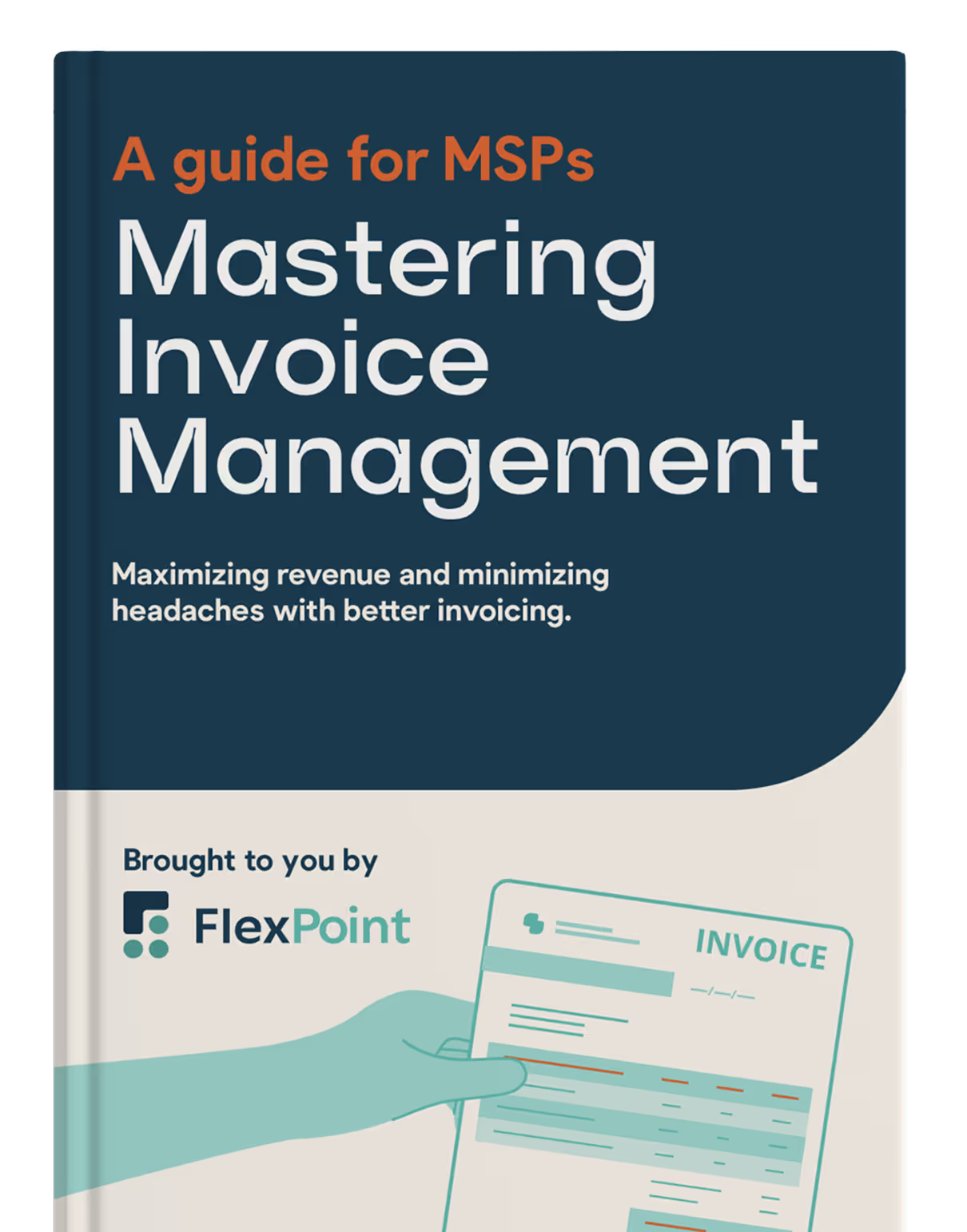Achieving Billing Accuracy with Automated MSP Solutions
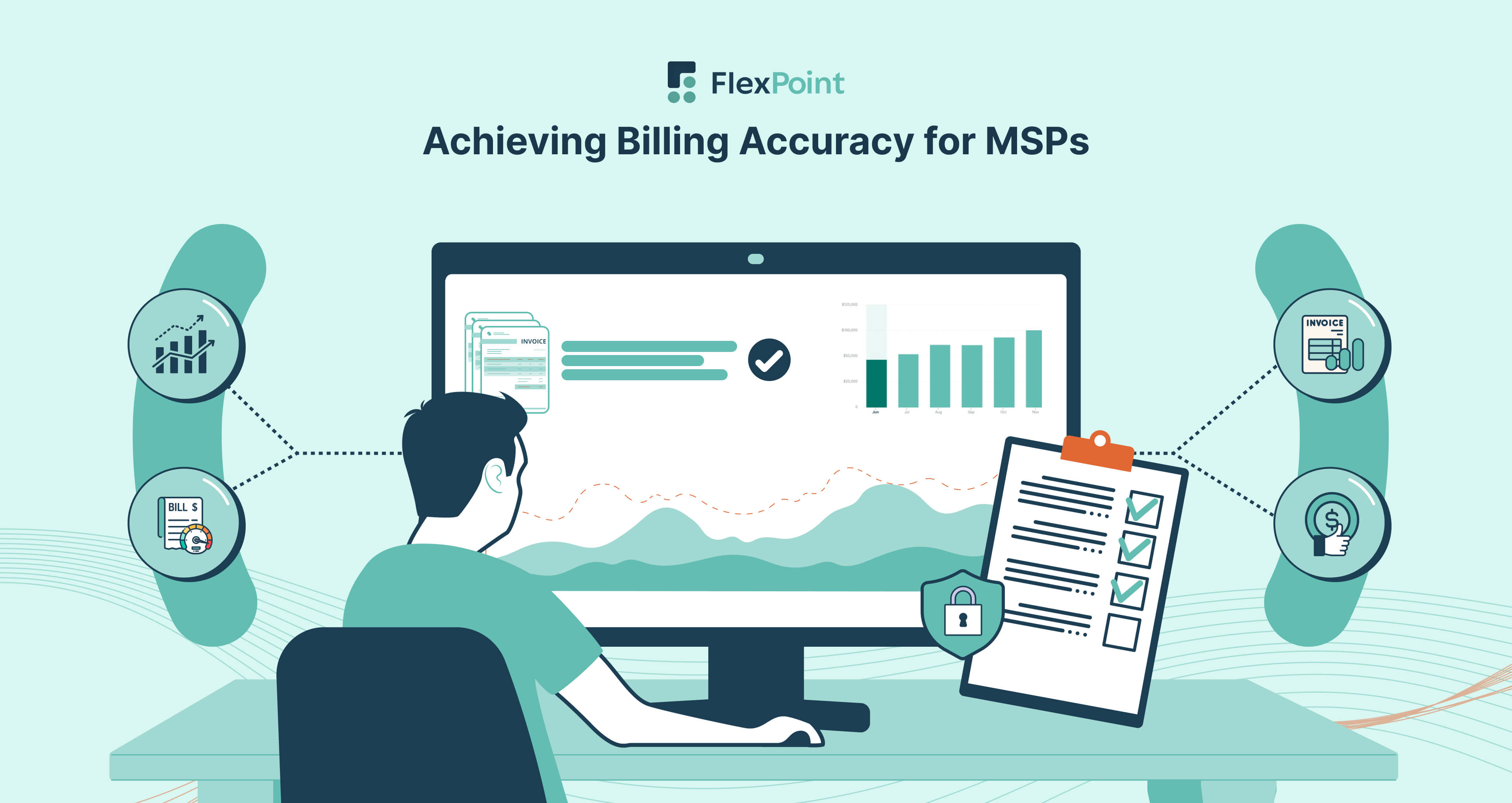
Invoicing and billing errors can lead to payment delays, strained client relationships, and unnecessary revenue leakage, all of which impact long-term business success.
However, many MSPs still use manual billing processes, which often result in frequent errors.
According to the Institute of Finance & Management (IOFM), 12.5% of manual invoices contain 100-400 errors per 5,000 entries.
These invoicing mistakes lead to payment disputes and additional corrective work.
Also, inaccurate service charges further frustrate clients and increase administrative strain.
Using automation, MSPs can eliminate manual billing, ensure error-free invoicing, faster payment cycles, and real-time financial insights.
This will also provide greater transparency into revenue trends and payment statuses, empowering MSPs to optimize cash flow and strengthen client relationships.
In this article, we will examine how automation ensures billing accuracy for managed service providers (MSPs), ultimately improving financial health and strengthening client relationships.
{{toc}}
The Importance of Billing Accuracy in MSP Operations
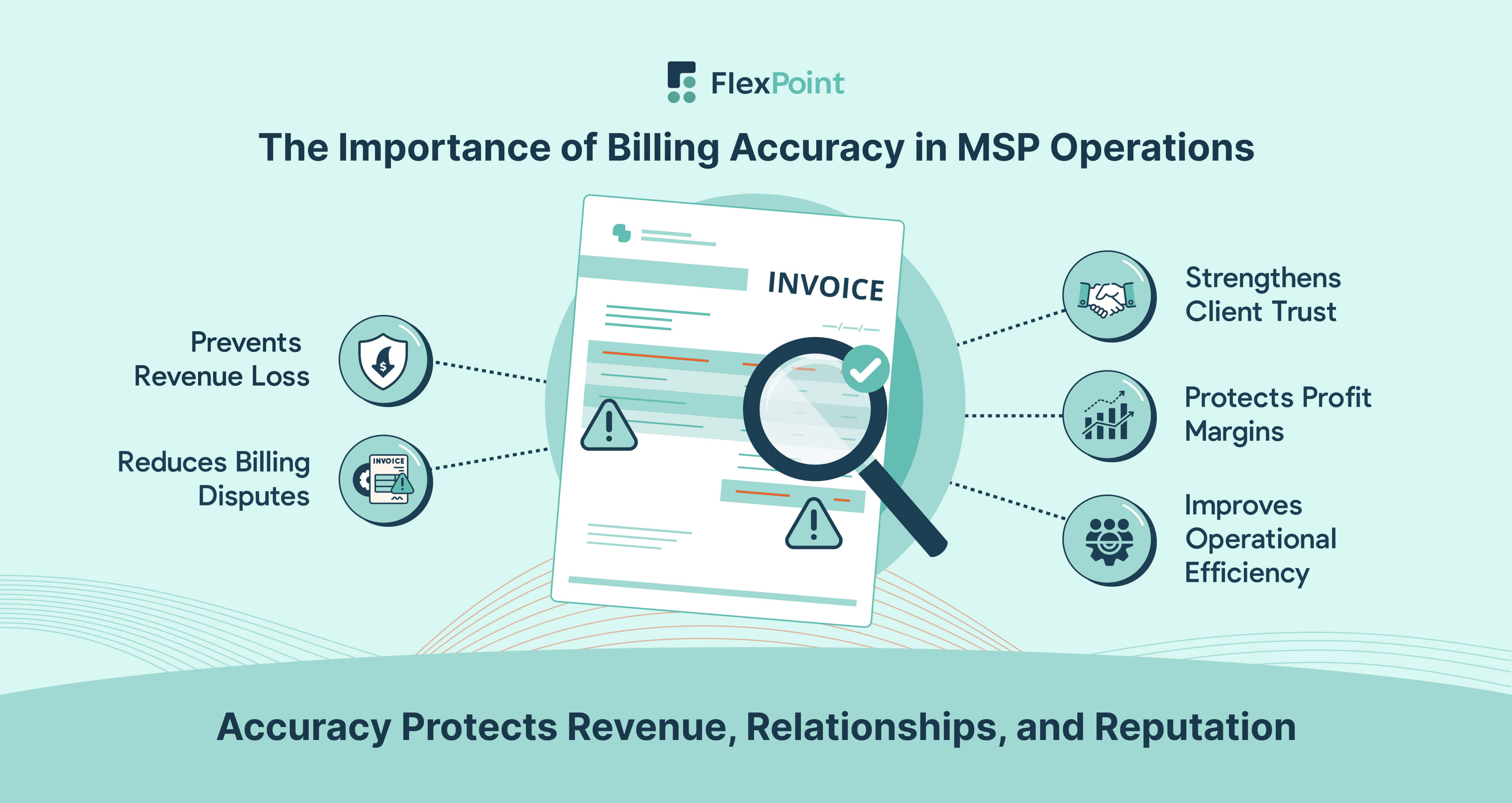
For MSPs, getting billing right is crucial for maintaining a healthy business. When your billing runs smoothly, everything else falls into place. You get paid on time, can track services accurately, and have a predictable income to grow your business.
Most importantly, it lets you focus on what matters, i.e., servicing clients and expanding your services.
However, the immediate impact is lost revenue when invoices contain mistakes, whether undercharging, overcharging, or incorrect service details.
Overbilling may seem like a short-term gain, but it often leads to refunds, credits, or painful negotiations to resolve disputes. Even minor, frequent errors add up, silently eroding the bottom line.
Overcharges frustrate clients, leading them to question the MSP’s attention to detail and, unfortunately, also the integrity of the MSP team.
Underbilling means the MSP isn’t paid for work performed, directly shrinking profits.
While undercharges might go unnoticed at first, when corrected later, clients may resist paying the difference, arguing the mistake wasn’t their fault.
These conflicts waste time as MSP finance teams scramble to investigate and correct errors, diverting focus from strategic work.
Worst of all, billing errors damage trust, the foundation of any MSP-client relationship.
If invoices are frequently wrong, clients may assume the MSP is disorganized or careless, casting doubt on the quality of their entire service.
Once trust erodes, retaining the client becomes harder, and referrals dry up.
{{ebook-cta}}
5 Strategies and Best Practices to Improve MSP Billing Accuracy

According to PYMNTS, 80% of business executives reported losing clients due to payment errors.
Accurate billing is critical for MSPs to maintain profitability, client trust, and operational efficiency.
In this section, we will explore proven strategies and best practices for optimizing billing workflows, minimizing discrepancies, and ensuring financial transparency.
1. Automating Invoicing to Eliminate Manual Errors
According to Docuclipper, humans commit 100x more errors than automated data entry.
Manual billing processes are prone to costly mistakes, such as data entry errors, incorrect charges, overbilled work, and miscalculations.
This often means MSPs and their finance teams review spreadsheets, copy data from tickets or time logs, and type up invoices line by line.
When billing isn’t accurate, you risk more than just a few lost dollars. Clients can lose trust when they’re overcharged or billed for services they didn’t receive. On the other hand, undercharging erodes revenue and profits without the business even realizing it.
Billing disputes can also slow down cash flow and strain relationships, forcing teams to waste time correcting mistakes instead of focusing on delivering better service.
The Solution: Automating the invoicing process is one of the most effective ways to fix these issues.
With the right tools, you can pull time logs, service data, and ticket information directly from your PSA and accounting systems.
This information is then used to automatically generate accurate invoices based on predefined rules and service agreements.
Invoice automation significantly reduces human error by eliminating the need for manual entry and calculations, ensuring that every invoice reflects the actual work done.
When invoicing is automated, your entire billing operation becomes faster, more consistent, and far less error-prone.
You can trust that your clients are being billed correctly every time, thus improving revenue capture and building client confidence and satisfaction.
Additionally, automation saves staff time, allowing finance and operations teams to focus on more strategic work instead of chasing down errors.
Let’s take an example of a mid-sized MSP struggling with inaccurate invoices. Their billing team must manually compile service tickets, cross-reference hours from different technicians, and calculate charges at the end of each month.
It isn’t unusual for clients to push back on unclear charges, leading to weeks of back-and-forth corrections.
The MSP then implements an automated invoicing tool that integrates with its PSA platform. Within the first month, billing errors usually drop dramatically.
Service hours and billable items will be automatically pulled into invoices based on client-specific contracts.
The team no longer has to second-guess whether all services are accounted for or whether rates have been applied correctly.
As a result, the MSP’s billing cycle shrinks significantly, and the finance team could spend more time analyzing profitability instead of fixing errors.
2. Using Real-time Data Syncing to Prevent Billing Discrepancies
Many MSPs utilize multiple tools to manage their businesses, including a PSA to handle tickets, an RMM for monitoring, and accounting software to generate invoices.
The challenge is that these tools often don’t communicate with each other in real-time. When information is updated in one system but not reflected in others, it creates gaps and inconsistencies.
When systems are out of sync, billing becomes a game of guesswork. Clients may be billed for services they didn’t receive or for work that was not billed.
This creates confusion, delays payment, and puts your credibility at risk. Over time, recurring billing issues can erode trust and lead to contract cancellations, making it more challenging to grow or retain business.
The Solution: Automating the data flow between PSA accounting tools and billing software ensures that billing always accurately reflects the delivered services.
By integrating PSA, billing software, and accounting tools, MSPs can automatically share and update data in real time, creating a single source of information. When a technician logs time in the PSA, it’s instantly reflected in the accounting system.
Real-time syncing reduces the risk of human error and removes the need for manual updates between systems.
This means more accurate invoices, fewer client disputes, and faster payments. It also makes life easier for your internal finance teams, who don't need to double-check every invoice.
Let’s use Skycamp Technologies, an Ohio-based MSP, for example. They manage their billing using multiple payment processing platforms. While they also considered using QuickBooks ACH, it critically lacked full integration with their invoicing platform.
Lack of integration meant Dan Illausky, President at SkyCamp, had to manually process each payment because invoice amounts varied based on customer license counts.
This manual process was incredibly time-consuming, and they were ready for a complete overhaul of their billing operations.
They sought a new partner that could provide end-to-end automation to reduce time spent on accounting and manual reconciliation. This was crucial to ensure that the company’s books were error-free.
Implementing FlexPoint was a straightforward process for SkyCamp, which was described as easy. A key step was being able to sync with QuickBooks.
Among the systemic improvements experienced by SkyCamp, the auto-syncing and reconciliation with QuickBooks Online were particularly impactful.
The auto-syncing and reconciliation feature provides SkyCamp with the peace of mind that any mistakes have been caught.
As a result, they eliminated 8 hours of work per month and hastened payment from late clients by 30%.
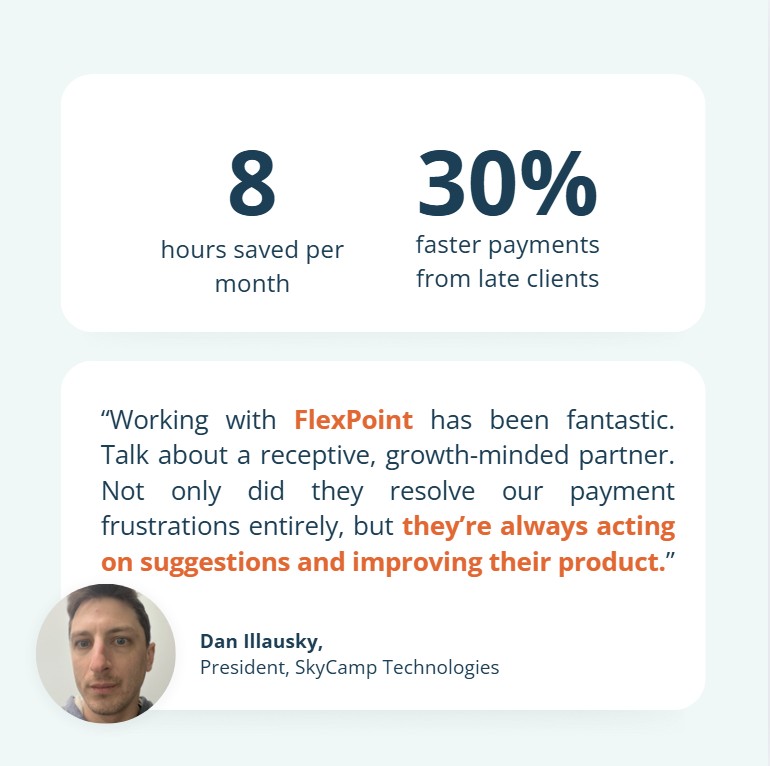
3. Implementing Standardized Billing Policies to Ensure Consistency
Many MSPs operate without a clear and consistent billing policy. Clients are billed differently: some by the hour, some on fixed rates, and some based on monitoring-only agreements.
When billing practices are inconsistent, it can be challenging for you and the client to know what to expect.
Clients may be surprised by charges, question their invoices, or delay payments until issues are clarified.
Internally, the billing team spends extra time figuring out how each client should be billed, leading to avoidable mistakes and slow turnaround times.
The Solution: Implement standardized billing policies across the board. This means setting clear pricing structures for all services.
It also defines what’s included in each service tier, uses documented service agreements (SLAs), and adheres to a set billing cycle, whether monthly, quarterly, or annually.
Once these rules are defined, they should be integrated into the PSA and accounting systems to enable automated and repeatable billing.
This ensures that clients know exactly what they’re paying for, when to expect their invoice, and what’s included in their service. It reduces back-and-forth questions and builds client confidence.
4. Leveraging AI and Automation to Detect and Correct Errors
According to Skyquest, 57% of MSPs are prioritizing the use of AI.
MSPs often manage a high volume of service tickets, time entries, and recurring billing tasks every month.
With so much data moving between systems, minor oversights, such as an unlogged task, an incorrect rate, or duplicated charges, can slip into invoices.
This lead may dispute charges, delay payment, or request lengthy clarifications. It will slow cash flow and also consume staff time that could be spent on more valuable tasks.
Over time, recurring errors, even minor ones, can weaken client relationships and hurt the MSP’s reputation.
The Solution: Utilizing AI and automation to review billing data before it is sent to clients can significantly reduce these issues.
AI-powered analytics tools will scan invoices for commonalities or possible mistakes.
This includes sudden jumps in service hours, unusual billing patterns, or missing charges compared to previous months.
These help identify potential issues for review before the invoice is finalized.
With AI and automation in place, billing becomes smarter and more accurate. Instead of relying on staff to manually catch every issue, the system handles most of the heavy lifting.
This means fewer payment errors, faster billing cycles, and fewer disputes with clients. It also gives MSPs better insight into billing trends and performance.
5. Enhancing Financial Reporting and Audit Trails for Accuracy
When there’s no solid reporting or audit trail, it becomes difficult to trace errors back to the source. This creates confusion within the team and weakens client trust when invoices can’t be adequately explained.
Over time, this lack of clarity can lead to recurring issues, delayed payments, and even compliance risks. This is especially possible if you serve clients in regulated industries (such as Healthcare, Banking, Government, etc).
The Solution: The best way to address this issue is to enhance financial reporting and establish a robust audit trail.
This means using systems that log every billing-related action, such as time entries, rate changes, approvals, and invoice edits, in a transparent and traceable manner.
Detailed reports should show what was billed, why, and how it aligns with the client’s service agreement.
With detailed and accurate records, your team can quickly identify and correct inconsistencies before they reach the client.
If any questions or discrepancies arise, you have the documentation to support the invoice, which helps avoid payment disputes and ensures smooth billing cycles.
Payment audit trails also enhance internal accountability, as everyone involved in the billing process is aware that their actions are being logged.
Conclusion: Strengthening MSP Financial Operations with Billing Accuracy
Manual billing processes are prone to errors, leading to client dissatisfaction and financial discrepancies.
Incorrect invoices are responsible for over 60% of payment delays, disrupting cash flow and making it difficult for MSPs to sustain operations, pay staff, or invest in growth.
Fixing these errors requires time-consuming follow-ups and corrections, which can be frustrating for clients.
To improve billing accuracy, MSPs should implement automated invoicing, real-time data syncing, and AI-driven billing validation.
Automated billing generates invoices based on predefined cycles and client-specific details, ensuring consistency and reducing manual effort.
FlexPoint is purpose-built to help MSPs streamline billing operations, reduce errors, and gain stronger financial insights.

By automating key billing processes and integrating with the tools you already use, FlexPoint enables operational efficiency and financial clarity at scale.
- Automated Invoicing: FlexPoint eliminates the risk of human error by automating the entire invoicing process. It integrates seamlessly with leading PSA platforms (such as ConnectWise, Autotask, HaloPSA, SuperOps) and accounting platforms (such as QuickBooks Online, QuickBooks Desktop, Xero), ensuring that usage, services, and contract changes are accurately reflected in real-time.
- Faster Collections: FlexPoint helps MSPs accelerate their collections process by generating precise and professional invoices on time. Clear, consistent invoicing reduces customer confusion and back-and-forth communication, leading to quicker approvals and payments.
- Automated Reconciliation: FlexPoint automates this process by matching billing data with contracts, service records, and payment details to ensure accurate reconciliation. This ensures precise, real-time financial records with significantly less manual intervention, freeing finance teams to focus on higher-value tasks.
- Centralized Billing Data: With FlexPoint, all billing-related information, including invoice history and payment status, is consolidated into one centralized platform. This unified view enhances data accuracy, reduces duplication, and provides clear audit trails.
- Stronger Financial Integrity: FlexPoint’s transparent processes and audit-ready records enable MSPs to maintain compliance, resolve disputes efficiently, and uphold high financial standards.
Ensure billing accuracy and financial stability with FlexPoint’s automated MSP billing solutions. Reduce errors, streamline invoicing, and improve client trust today.
Schedule a demo to see how FlexPoint can transform your MSP’s billing operations.
{{demo-cta}}
Additional FAQs: MSP Billing Accuracy & Automation
{{faq-section}}



